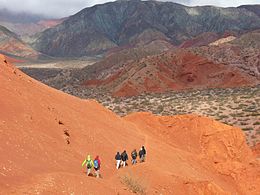
Back Macəra turizmi Azerbaijani Oplevelsesrejse Danish Abenteuerreise German Aventura turismo Esperanto Turismo de aventura Spanish Seiklusturism Estonian Abentura-turismo Basque سفر ماجرایی Persian Tourisme d'aventure French रोमांच यात्रा Hindi
This article has multiple issues. Please help improve it or discuss these issues on the talk page. (Learn how and when to remove these template messages)
|


Adventure travel is a type of tourism, involving exploration or travel with a certain degree of risk (real or perceived), and which may require special skills and physical exertion. In the United States, adventure tourism has seen growth in late 20th and early 21st century as tourists seek out-of-the-ordinary or "roads less traveled" vacations, but lack of a clear operational definition has hampered measurement of market size and growth. According to the U.S.-based Adventure Travel Trade Association, adventure travel may be any tourist activity that includes physical activity, a cultural exchange, and connection with outdoor activities and nature.[1]
Adventure tourists may have the motivation to achieve mental states characterized as rush or flow,[2] resulting from stepping outside their comfort zone. This may be from experiencing culture shock or by performing acts requiring significant effort and involve some degree of risk, real or perceived, or physical danger. This may include activities such as mountaineering, trekking, bungee jumping, mountain biking, cycling, canoeing, scuba diving, rafting, kayaking, zip-lining, paragliding, hiking, exploring, Geocaching, canyoneering, sandboarding, caving and rock climbing.[3] Some obscure forms of adventure travel include disaster and ghetto tourism.[4] Other rising forms of adventure travel include social and jungle tourism.
Access to inexpensive consumer technology, with respect to Global Positioning Systems, flashpacking, social networking and photography, have increased the worldwide interest in adventure travel. The interest in independent adventure travel has also increased as more specialist travel websites emerge offering previously niche locations and sports.
Adventure sports tourism has traditionally been dominated by men. Although women's participation has grown, the gender gap is still pronounced in terms of quantitative engagement in these forms of sport tourism. Yet, in competitive adventure sport tourism, the success rate of females is currently higher than that of males [5]
- ^ "ATTA Values Statement" (PDF). adventuretravel.biz. Adventure Travel Trade Association. February 2013. p. 2. Retrieved 27 July 2015.
- ^ Buckley, Ralf (2012). "Rush as a key motivation in skilled adventure tourism: Resolving the risk recreation paradox". Tourism Management. 33 (4): 961–970. doi:10.1016/j.tourman.2011.10.002. hdl:10072/46933.
- ^ "Adventure Travel". Centers for Disease Control and Prevention. 26 April 2013. Retrieved 27 July 2015.
- ^ "Citypaper online". Archived from the original on 13 October 2007. Retrieved 2007-11-10.
- ^ Apollo, M., Mostowska, J., Legut, A., Maciuk, K., & Timothy, D. J. (2023). Gender differences in competitive adventure sports tourism. Journal of Outdoor Recreation and Tourism, 42, 100604. https://doi.org/10.1016/j.jort.2022.100604